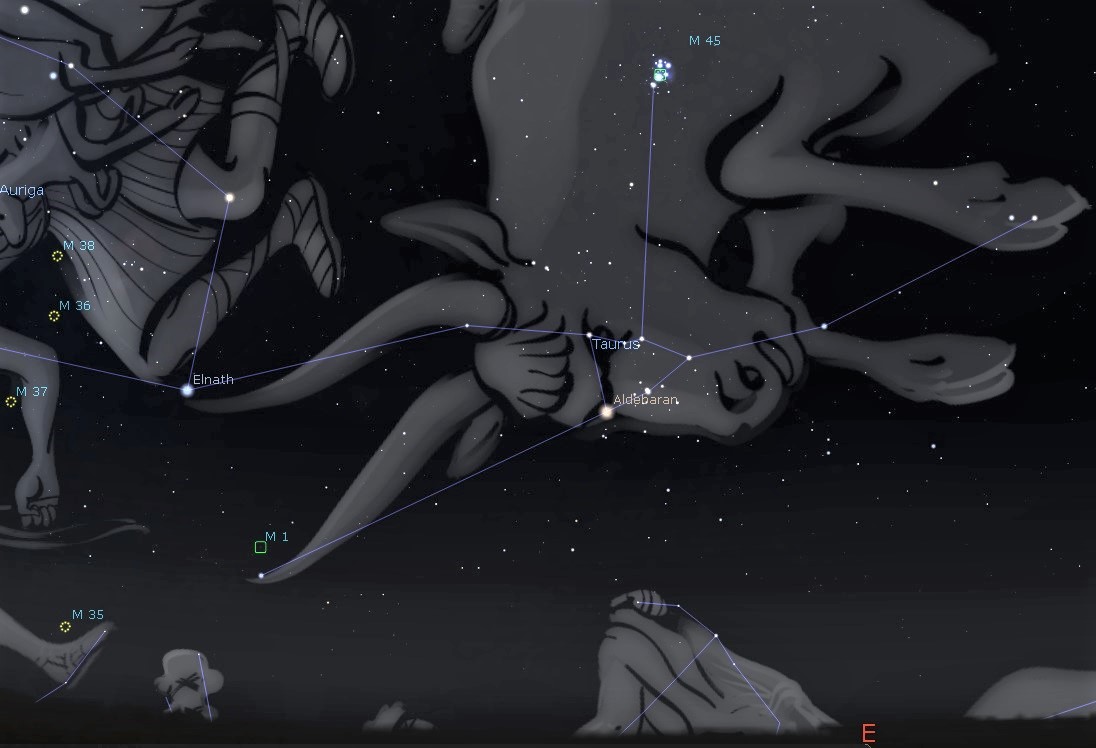This Week’s Sky at a Glance, 2021 October 16 – 23 ~by Curt Nason
The Pleiades star cluster is rising now in the early evening. Also known as M45 or the Seven Sisters, and sometimes mistaken to be the Little Dipper, this compact eye-catcher represents the shoulder of Taurus the Bull. Over the next two hours the rest of the constellation clears the eastern horizon; in particular, the V-shaped Hyades star cluster anchored by orange Aldebaran, and the two stars marking the tips of the bull’s long horns.
In mythology, Zeus changed himself into a beautiful white bull to attract the attention of Europa, a princess of Sidon. She was taken by its gentleness and made the mistake of climbing on its back. Bully Zeus took off to the nearby seashore and swam all the way to Crete, where he changed back into his godly form and completed his conquest. The result was a baby boy who was named Minos, and he grew up to become the first King of Crete.
One of the horn stars of Taurus had been shared with the constellation Auriga. This star, Elnath, was officially assigned to Taurus when the constellation boundaries were set by the International Astronomical Union (IAU) in the late 1920s. Taurus is one of the zodiac constellations, as the ecliptic passes between the Pleiades and Hyades and also between the horn-tips. Since the Moon’s orbit is tilted to the ecliptic by about five degrees, at times it can be seen passing in front of the Pleiades and Aldebaran.
This Week in the Solar System
Saturday’s sunrise in Moncton is at 7:37 am and sunset will occur at 6:30 pm, giving 10 hours, 53 minutes of daylight (7:41 am and 6:36 pm in Saint John). Next Saturday the Sun will rise at 7:47 am and set at 6:18 pm, giving 10 hours, 31 minutes of daylight (7:51 am and 6:25 pm in Saint John).
The Full Hunter’s Moon occurs on Wednesday, a phenomenon similar to the Harvest Moon by which moonrises occur 20-30 minutes later over several days rather than the average 50 minute difference. Venus sets around 8:20 midweek, while Saturn is highest in the sky at 8 pm followed by Jupiter an hour later. Jupiter is stationary on Monday, resuming its eastward motion against the stars. On Wednesday telescope users might catch its moon Callisto begin to cross in front of the planet at 8:24 pm, followed by Io four minutes later. Speedier Io will soon overtake Callisto. Mercury begins its best morning apparition for the year this week, reaching a stationary position relative to the stars on Sunday. The Orionid meteor shower peaks Thursday morning but moonlight will hamper viewing somewhat.
Questions? Contact Curt Nason.

